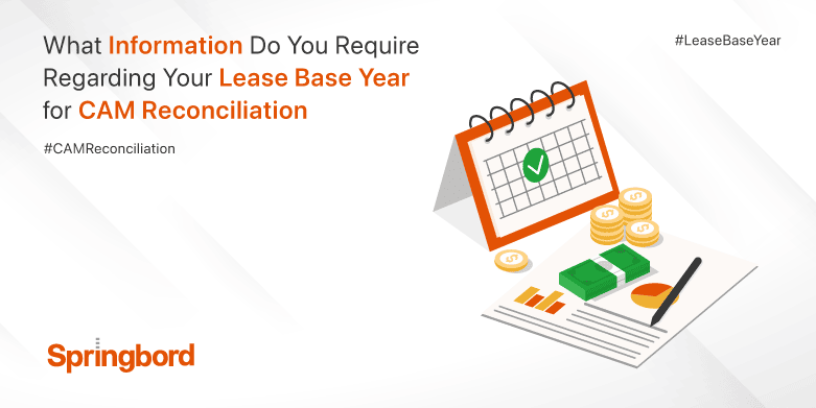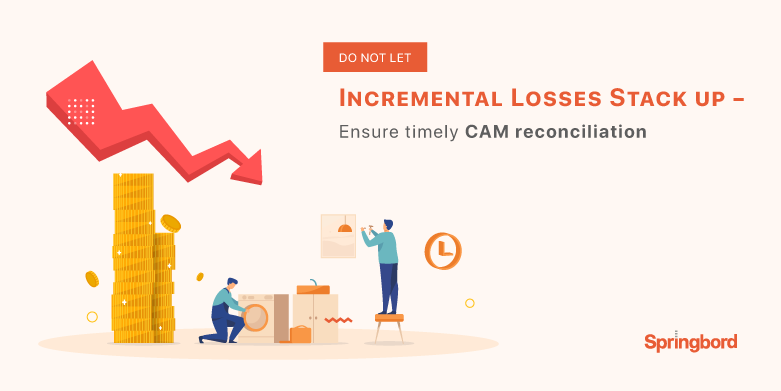 Read time 3 min
Read time 3 minCAM (Common Area Maintenance) reconciliation is an important process for commercial property landlords and tenants to understand. It involves comparing the actual expenses incurred for maintaining and operating a property during a specific period, known as the “current year,” to the expenses that were budgeted for that period, known as the “base year.” The difference between the two is then allocated among the tenants according to their lease agreements.
One key aspect of CAM reconciliation is understanding how the base year expenses are calculated. As a CAM reconciliation service provider, Springbord helps landlords and tenants navigate this process.
In this blog post, we’ll cover some key things you need to know about your CAM reconciliationhttps://blog.mobiusservices.com/what-is-cam-audit/ lease base year, including grossed-up expense calculation, deferred expenses, and comparing service levels with the base year.
To help you understand these ideas, we have also given you some mathematical examples.
Grossed-up Expense Calculation
The grossed-up expense calculation is used to determine the base year expenses that were allocated to each tenant. It takes into account both the direct expenses (such as property taxes and insurance) and the indirect expenses (such as management fees and utilities) that are associated with maintaining and operating the property.
To calculate the grossed-up expenses, the direct expenses are multiplied by a “gross-up factor”, which is determined by the lease agreement. For example, if the lease agreement states that the gross-up factor is 1.2, and the direct expenses for the base year are $100,000, the grossed-up expenses would be $120,000 ($100,000 x 1.2).
The calculation of grossed-up expenses is done using the following formula:
Grossed-up Expenses = Direct Expenses x (1 + Gross-up Factor)
Deferred Expenses
Deferred expenses refer to expenses that were incurred during the base year but were not paid until the current year. These expenses must be taken into account when determining the base year expenses, as they were part of the budget for that year.
To calculate deferred expenses, the unpaid expenses from the base year are added to the grossed-up expenses. For example, if the deferred expenses for the base year are $20,000, and the grossed-up expenses are $120,000, the total base year expenses would be $140,000 ($120,000 + $20,000).
In mathematical terms, the formula for calculating deferred expenses is:
Deferred Expenses = Grossed-up Expenses + Unpaid Expenses from Base Year
Comparing Service Levels with the Base Year
Another important aspect of CAM reconciliation is comparing the current year’s service levels to the base year’s service levels. This is necessary to ensure that the tenants are being charged for the services they are receiving.
To compare service levels, the landlord must examine the services that were provided during the current year and compare them to the services that were budgeted for the base year. Any discrepancies should be taken into account when determining the tenant’s CAM charges.
For example, if the base year budgeted for landscaping services twice a week, and the current year only provided once-a-week service, the tenant should not be charged the same amount as they would have been if the service level had remained the same.
Conclusion
Commercial landlords and tenants need to reconcile CAM costs regularly. An understanding of the gross-up expense calculation, deferred expenses, and service level comparisons to the base year is essential for tenants to make reliable CAM cost estimates. Springbord facilitates thought processing and improves the capability to navigate and ensure accurate CAM reconciliation.
To avoid overpaying your lease, we may assist you in calculating your actual costs. For assistance with your CAM reconciliation review, you may rely on Springbord’s lease audit team, which is equipped to handle even the most difficult lease-related issues.
A landlord can choose from having us perform anything from a simple computer audit to a comprehensive onsite inspection of their financial records. Reach out to us immediately if you need help figuring out how to start analyzing your base year data.







